The quest for past
The quest for truth has been innate in the human mind, since time immemorial. Right from the Vedic times, as the Nasadiya sukta tell us, man has been wondering as to whom and how did the universe appear as they do now. While the quest has been undertaken on meta-physical levels, with questions being raised on the 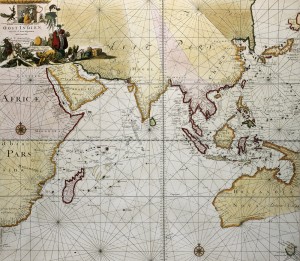 practicality or impracticality of a supreme creator, this has in no way heeded the efforts to find the origins of the past. To know, from where it all began in a logical and chronological sequence. This quest for answers for roots lies at the very heart of archaeology.
practicality or impracticality of a supreme creator, this has in no way heeded the efforts to find the origins of the past. To know, from where it all began in a logical and chronological sequence. This quest for answers for roots lies at the very heart of archaeology.
In practical terms, archaeology is the physical effort undertaken to unravel the past. A scientific approach that either substantiates or debunks propositions from the past. The precise definition, reads something like this:
The systematic study of past human life and culture by the recovery and examination of remaining material evidence, such as graves, buildings, tools, and pottery.
But this quest for past has not been a recent one, many centuries yore, too people have been looking for answers in mythology, literature and religious books to discover the roots. The earliest historians, who documented India, were the religious or rather Buddhist travellers who came down to India with the objective of finding the real source of Buddhist literature.
Foreign nationals from across the shores or Himalayas have been frequent visitors to Indian since time immemorial as traders, travellers, scholars, and finally as rulers. One of the biggest fascinations for these travellers has been the immense wealth of epigraphical, architectural and sculptural material that is found in this region.
One of the first major documented visitors to Indian continent have been the 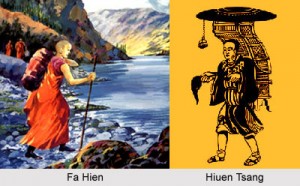 Chinese travellers Fa-hien (5th century CE) and Xuanzang (Hieun-Tsang-7th century CE) were interested in Buddhist remains and have left accounts of numerous cities and sites related with Buddhism, such as Nalanda, Bodh Gaya and Ajanta. Through their works, one is able to draw a clear anthropological picture of the time and lifestyles of Indians of those era.
Chinese travellers Fa-hien (5th century CE) and Xuanzang (Hieun-Tsang-7th century CE) were interested in Buddhist remains and have left accounts of numerous cities and sites related with Buddhism, such as Nalanda, Bodh Gaya and Ajanta. Through their works, one is able to draw a clear anthropological picture of the time and lifestyles of Indians of those era.
In fact the name that stands out or comes to the memory is that of Hsuen Tsang – Xuanzang [c.602 – 664] was a famous Chinese Buddhist monk, scholar, traveler, and translator who described the interaction between China and India in the early Tang period.
Born in Henan province of China in 602 or 603, from boyhood he took to reading sacred books, mainly the Chinese Classics and the writings of the ancient sages. While residing in the city of Luoyang, Xuanzang entered Buddhist monkhood at the age of thirteen and developed the desire to visit India. He knew about Faxian’s visit to India and, like him, was concerned about the incomplete and misinterpreted nature of the Buddhist scriptures that reached China.
He became famous for his seventeen year overland trip to India and back, which is recorded in detail in his autobiography and a biography.
But even still, much prior to the visits undertaken by the Chinese visitors, there was traveller to India, who left copious amount on literature on the way things worked in India in the 3rd century BCE. Megasthenes was a Greek ethnographer, who was sent as a royal ambassador by Seleucus I, post his defeat by Chandragupta Maurya. He spent many years travelling across the length and breadth of the Mauryan Empire and authored a detailed account of his journeys, titled, Indica.
In fact, Megasthenes’ Indica is the first Western well known account of India, and has been a basis for many subsequent works. For his much amazing work, Megasthenes is regarded by the Western School as one of the founders of the study of Indian history.
His account is much respected not only in terms of the details, it provides in terms of the political, military and social milieu of that time, but also a religious enquiry on the evolution of the cultural set up. For instance, there is an interesting comparison made by Megasthenes on the commonality of mythology, both Greek and Indian.
From 7th century onwards, there were many travellers and traders from Arab and Middle East, who started visiting India, and described the cities and lifestyle of those times.
The two names that stand out among the Arab travellers to have visited the Indian subcontinent were, Al-Buruni & Ibn Batuta. The first one to have landed in India, was Al-Buruni. It is assumed that it was in 1017 that he travelled to the Indian subcontinent and became the most important interpreter of Indian science to the Islamic world. He is given the titles the “founder of Indology” and the “first anthropologist”. He was an impartial writer on custom and creeds of various 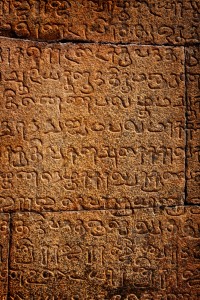 nations, and was given the title al-Ustdadh (“The Master”) for his remarkable description of early 11th-century India.
nations, and was given the title al-Ustdadh (“The Master”) for his remarkable description of early 11th-century India.
Al-Biruni wrote an encyclopaedic work on India called “Tarikh Al-Hind” (History of India, also known as “Indica,” or simply “India”) in which he explored nearly every aspect of Indian life, including religion, history, geography, geology, science, and mathematics. He explores religion within a rich cultural context. Not only that Al-Biruni also collected books and studied with Hindu scholars to become fluent in Sanskrit. He translated books both from Sanskrit to Arabic and vice versa.
Meanwhile, Abū ‘Abd Allāh Muḥammad ibn ‘Abd Allāh al-Lawātī al-Ţanjī ibn Baṭūṭah or simply Ibn Batuta, visited Indian sometime in the 14th century to seek employment with the Muslim Sultan of Delhi, Muhammad bin Tughluq. Muhammad Ibn Tughluq was renowned as the wealthiest man in the Muslim World at that time. He patronised various scholars, sufis, Qadis, Viziers and other functionaries in order to consolidate his rule. Batuta, stayed over and travelled across for many years, his travel accounts are popular thanks to the book he composed, namely, the Rihla (or journeys).
From the 16th century CE onwards there are copious references to Indian monuments in the writings of European travellers
Much of these accounts are in great detail and embellished with much personal opinions. In fact, these writings by the numerous travellers are considered to be the first group of archaeological writings on India.
Nicolo Conti (1419-44), a Italian traveller and Athanasius Nikitin (1468), a Russian merchant, were among the first ones to have described the remains of Vijayanagara (Hampi, Karnataka).
William Finch (1608-1611) has left behind a journal with the accounts of architectural wealth of Delhi, Agra, Lahore and other historical places. Pietro della Valle travelled in India in 1623-25 and has left relatively objective account of temples at Surat, Cambay, Chaul etc.
Most of these observations are limited to the caves of Kanheri, Elephanta, Ellora and other cave-sites near Mumbai. Most of these writers were Portuguese since Mumbai islands were under their control. They described the caves, tried to place them chronologically and attempted to guess the authorship. Most were impressed by the grandeur of architecture, but were repelled by multi-armed sculptures of Hindu gods and goddesses.
Establishment of Asiatic Society
The officers of British East India Company had begun to take interest in antiquarian wealth of the country after establishing their foothold, following the Battle of Plassey in 1757. On 15th January, 1784, the Asiatic Society was founded in Calcutta by Sir William Jones to “inquire into the history and antiquities, the 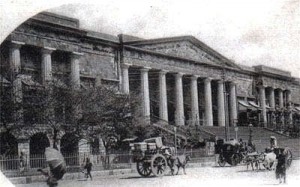 arts, sciences and literature of Asia”. An annual journal called Asiatic Researches was first issued in 1788. The foundation of the Asiatic Society was entirely in keeping with the scientific spirit of the 18th century Britain. The reasons for establishing the society were mainly a) to understand India better, since British now planned to rule the country, and b) to unravel the mysteries of India, which had become a matter of considerable theoretical interest to the western philosophical thinking. Jones, Charles Wilkins and others started translating Indian classics like Bhagvad Gita, Hitopadesh, Shakuntalam etc. These scholars were mainly interested in relating the emerging historical knowledge of India to the contemporary notions of the origin of culture and civilization. They provided a framework for interpreting the Indian past.
arts, sciences and literature of Asia”. An annual journal called Asiatic Researches was first issued in 1788. The foundation of the Asiatic Society was entirely in keeping with the scientific spirit of the 18th century Britain. The reasons for establishing the society were mainly a) to understand India better, since British now planned to rule the country, and b) to unravel the mysteries of India, which had become a matter of considerable theoretical interest to the western philosophical thinking. Jones, Charles Wilkins and others started translating Indian classics like Bhagvad Gita, Hitopadesh, Shakuntalam etc. These scholars were mainly interested in relating the emerging historical knowledge of India to the contemporary notions of the origin of culture and civilization. They provided a framework for interpreting the Indian past.
Epigraphy
Epigraphy is the study of inscriptions and ‘inscriptions’; literally means any writing engraved on some object. In India rocks as well as lithic, metallic, earthen or wooden pillars, tablets, plates and pots, as also bricks, shells, ivory plaques and other objects were generally used for incising inscriptions. Often writing in relief such as we find in the legends on coins and seals which are usually produced out of moulds or dyes, and also records painted on cave walls or written in ink on wooden tablets are regarded as inscriptions, although these writings are not actually engraved. The letters of certain late medieval records in the indigenous Indian alphabets are generally not engraved but are formed by scooping out the space around them.
Similarly, Numismatics (Latin: numisma, nomisma , “coin”; from the Greek) is the study or collection of currency, including coins, tokens, paper money, and related objects. While numismatists are often characterized as students or collectors of coins, the discipline also includes the broader study of money and other payment media used to resolve debts and the exchange of goods
Numismatics: an enquiry
Numismatics is the study of coins. It is important for the study of history, especially ancient history. It confirms, modifies and even amplifies history. To a great extent the political and economic history of country is constructed by 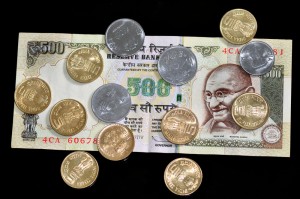 numismatics and historical facts are very often corroborated or rejected by numismatic findings. Many facts connected with administration, historical geography and religious history of ancient India are revealed to us by numismatics. Epigraphy and numismatics play a vital role in the reconstruction of Ancient Indian History because of the fact that unlike Greece, Rome or China, Ancient India has no history, because the Indians of antiquity did not care to leave written accounts of all their achievements. It is believed that Numismatics and epigraphy merely confirms history but seldom modifies or amplifies it. However this does not hold true for India. No connected written history of India for any period prior to the Muhammadan conquest has come down to us. We therefore have the construct it as best as we can out of the materials at our disposal. These belong to two main classes, the first of which consists of works written as panegyrics by Hindu authors or as descriptive accounts by foreign travellers and historians. The second class of materials is of more important nature, and comprises of epigraphy and numismatics. Though it has been frequently stated the, importance of epigraphy in Indology can hardly be overemphasized. The primary reason for the particular importance of epigraphy in the study of traditional India is extreme scarcity of information, especially in the ancient period, of the type of historical data from literary sources which is available for other major civilizations of the ancient and medieval world. This situation is a reflection of what might be called the “historical” orientation of traditional Indian culture. Traditional India, with its strongly idealistic and theoretical orientation, had little interest in what we in the modern world think of as “history”, and except for a few outstanding exceptions, Sanskrit and classical literature include little in the way of “historical” texts in the stricter term. As a result, the history of ancient and early medieval India must for the most part be reconstructed from incidental sources; that is sources whose original intent was something other than the recording of historical events as such.
numismatics and historical facts are very often corroborated or rejected by numismatic findings. Many facts connected with administration, historical geography and religious history of ancient India are revealed to us by numismatics. Epigraphy and numismatics play a vital role in the reconstruction of Ancient Indian History because of the fact that unlike Greece, Rome or China, Ancient India has no history, because the Indians of antiquity did not care to leave written accounts of all their achievements. It is believed that Numismatics and epigraphy merely confirms history but seldom modifies or amplifies it. However this does not hold true for India. No connected written history of India for any period prior to the Muhammadan conquest has come down to us. We therefore have the construct it as best as we can out of the materials at our disposal. These belong to two main classes, the first of which consists of works written as panegyrics by Hindu authors or as descriptive accounts by foreign travellers and historians. The second class of materials is of more important nature, and comprises of epigraphy and numismatics. Though it has been frequently stated the, importance of epigraphy in Indology can hardly be overemphasized. The primary reason for the particular importance of epigraphy in the study of traditional India is extreme scarcity of information, especially in the ancient period, of the type of historical data from literary sources which is available for other major civilizations of the ancient and medieval world. This situation is a reflection of what might be called the “historical” orientation of traditional Indian culture. Traditional India, with its strongly idealistic and theoretical orientation, had little interest in what we in the modern world think of as “history”, and except for a few outstanding exceptions, Sanskrit and classical literature include little in the way of “historical” texts in the stricter term. As a result, the history of ancient and early medieval India must for the most part be reconstructed from incidental sources; that is sources whose original intent was something other than the recording of historical events as such.
Inscriptions have played hence a very vital role in the reconstruction of ancient Indian history. It is estimated that 80 percent of our knowledge of the history of India before about A.D 1000 is derived from inscriptional sources. Without 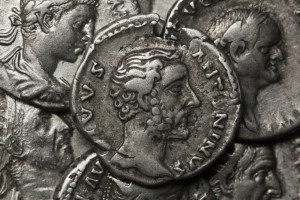 inscriptions we would have only the vaguest notion of the history of the Mauryan empire. The Asokan inscriptions were engraved on rocks and pillars. These are valuable sources for Mauryan Empire. The Hathi Gumpha inscription of King Kharavela found at Udaygiri, the Nasik prosasti of GautamaputraSatakarni, the Aihole inscription of Pulakesin II, the Junagarh inscriptions of Rudradaman are very important sources materials of those rulers. From the Boghaz-koi inscriptions found in Asia Minor we get an indicect referance about the arrival of the Aryans in India. The Allahabad prosasti of Samundra Gupta and the Gwalior prosasti of Bhoja give information about them. The inscriptions cannot be tampered so their authenticity is unquestionable. Epigraphy material, directly or indirectly, provide almost the only solid chronological foundation for modern historically oriented studies. This is true primarily because inscriptions are datable either by explicit dates or palaeographic estimates. In the construction of the ancient history of India, coins have been classed with inscriptions in point of importance. Numismatics is like epigraphy an important source of ancient Indian history and helps us construct history and not merely corroborate it. Thus comes the question of how Numismatics as compared to epigraphy has contributed to the reconstruction of Ancient Indian history. Let us go back to 250 B.C to about 300 A.D when Indo-Bactrian Greek, Indo-Scythian, Indo-Parthian and Kushana kings, whose might overshadowed the North of India. Our knowledge of the indo-Bactrian Greek princes would be nothing had it not been due to the study of coins. Yes, Greek historians like Justin and Strabo have preserved an account of some of them, but this account is of four or five princes only and ranges scarcely half a century. On the other hand, a study of their coins reveal to us no less than 37 such Greek princes, whose sway extends over 2 centuries and a half.
inscriptions we would have only the vaguest notion of the history of the Mauryan empire. The Asokan inscriptions were engraved on rocks and pillars. These are valuable sources for Mauryan Empire. The Hathi Gumpha inscription of King Kharavela found at Udaygiri, the Nasik prosasti of GautamaputraSatakarni, the Aihole inscription of Pulakesin II, the Junagarh inscriptions of Rudradaman are very important sources materials of those rulers. From the Boghaz-koi inscriptions found in Asia Minor we get an indicect referance about the arrival of the Aryans in India. The Allahabad prosasti of Samundra Gupta and the Gwalior prosasti of Bhoja give information about them. The inscriptions cannot be tampered so their authenticity is unquestionable. Epigraphy material, directly or indirectly, provide almost the only solid chronological foundation for modern historically oriented studies. This is true primarily because inscriptions are datable either by explicit dates or palaeographic estimates. In the construction of the ancient history of India, coins have been classed with inscriptions in point of importance. Numismatics is like epigraphy an important source of ancient Indian history and helps us construct history and not merely corroborate it. Thus comes the question of how Numismatics as compared to epigraphy has contributed to the reconstruction of Ancient Indian history. Let us go back to 250 B.C to about 300 A.D when Indo-Bactrian Greek, Indo-Scythian, Indo-Parthian and Kushana kings, whose might overshadowed the North of India. Our knowledge of the indo-Bactrian Greek princes would be nothing had it not been due to the study of coins. Yes, Greek historians like Justin and Strabo have preserved an account of some of them, but this account is of four or five princes only and ranges scarcely half a century. On the other hand, a study of their coins reveal to us no less than 37 such Greek princes, whose sway extends over 2 centuries and a half.
India is one of the oldest civilizations, and at least 5000 years of its history is 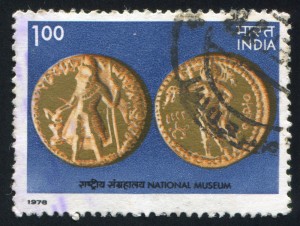 available in fragmentary form. Money, exchange, and rudimentary financial systems are mentioned in books written around 1000 BC, which means that it is one of the earliest countries to evolve a metal-based financial system. By 300 BC it had its own manual of economics written by the great thinker Kautilya (c 350–-283 BC).
available in fragmentary form. Money, exchange, and rudimentary financial systems are mentioned in books written around 1000 BC, which means that it is one of the earliest countries to evolve a metal-based financial system. By 300 BC it had its own manual of economics written by the great thinker Kautilya (c 350–-283 BC).
Though numerous coins have been found on the surface, many have been found while digging the mounds. The study of coins is called ‘numismatics’. Numismatics was used for historiography as far back as the 12th century by Kalhana, the author of, Rajatarangini. The earlier coins discovered in India are of copper and silver.
However, ancient coins of gold, lead, etc., have also been found. The earliest coins of India contain a few symbols, but the later coins mention the names of kings and gods or dates.
Ancient people would store money in earthenware or brass vessels. Many such hoards, containing I both indigenous coins and those minted abroad such I as in the Roman Empire, have been discovered in I different parts of the country.
The areas where they I are found indicate the region of their circulation. These coins have enabled us to reconstruct the history and extent of several ruling dynasties, especially of the Indo-Greeks.
About 31 of the Indo- Grcek kings and queens have been known mainly from coins alone. Much of the history of the Kushanas has been revealed to us through their coins. Much of the political life of the Sakas of Ujjain comes to us only through coins.
Coins are a good source of administrative as well as constitutional history. The ancient coins celebrate the victory of republics in some cases. They thus confirm the prevalence of a republican constitution in ancient India.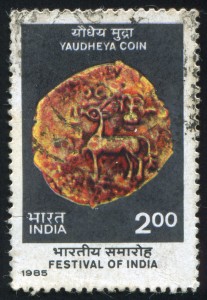
The administration under the Sakas and the Pahlavas has been reconstructed largely on the basis of coins. The purity of the coins also reveals the economic conditions of a period.
Coins also portray kings and gods, and contain religious symbols and legends, by which one can get an idea of the art and religion of the time. Portraits on some of the Indo-Greek coins are considered the best examples of ancient portraiture art.
The study of coins also called Numismatics is extremely revealing when it comes to revealing facts and customs of the period of that coin’s prevalence. The complexity that Numismatics offers is evident from the fact that the number of distinct dynasties that existed during that time tried to develop their own style of Coinage. Indeed it is the in-depth study of coinage over the years in India that has revealed the presence of many rulers and dynasties in India which otherwise could not have been justified.
The study of Kharoshti and Brahmni, which are the ancient texts of India were actually deciphered with the help of coinage of the Kushan Era. Many factors that help historians to decipher the possible rise and fall of various kingdoms and rulers are the change in design style, dates mentioned, some changes in language etc.
Each coin was developed for a special purpose during a specific era, which served as a great revelation over centuries. As in the vast and deep history of India there have numerous big and small dynasties and empires spreading across every part of the country, there was no rigid proof or evidence for their presence. However it is observed that nearly every Ruler tries to have their unique lineage of coins which when deciphered properly, gives umpteen information about the period. Coins help apprehend the socio-political, cultural and administrative aspects of past kingdoms and rulers.
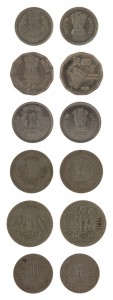 Numismatics also reveals the religious beliefs and sentiments during that time. For Example, it was first in the coins of Kanishka dynasty that Buddha was represented in form while earlier it was demonstrated symbolically. Similarly on the coins of Gupta Empire one can witness forms of Durga, Laxmi and Ganga.
Numismatics also reveals the religious beliefs and sentiments during that time. For Example, it was first in the coins of Kanishka dynasty that Buddha was represented in form while earlier it was demonstrated symbolically. Similarly on the coins of Gupta Empire one can witness forms of Durga, Laxmi and Ganga.
It was with the British taking authority of currency that the first stance of Modern coinage took birth in India. The first coinage under the crown was issued in 1862 and in 1877 Queen Victoria assumed the title of Empress of India. Edward VII ascended after Queen Victoria and the coins issued, bore his model.
Thus the history of Indian Coinage is both exciting yet complicated as it is immensely vast. Over umpteen reigns there has been a great lineage of coinage set by different rulers that throw a light on the customs and traditions of that Era. Thus, Numismatics is extremely important to get details on periodical changes in history.
